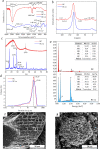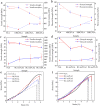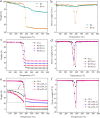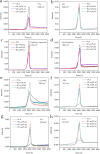Intumescent-Grafted Bamboo Charcoal: A Natural Nontoxic Fire-Retardant Filler for Polylactic Acid (PLA) Composites
- PMID: 34693119
- PMCID: PMC8529600
- DOI: 10.1021/acsomega.1c03393
Intumescent-Grafted Bamboo Charcoal: A Natural Nontoxic Fire-Retardant Filler for Polylactic Acid (PLA) Composites
Abstract
In this work, an alternative flame-retardant filler based on phosphate- and urea-grafted bamboo charcoal (BC-m) at 10-30 wt % addition was aimed at improving the flame retardancy of polylactic acid (PLA) composites. The filler caused only a small reduction in strength properties but a slight increase in the modulus of elasticity of PLA composites. BC-m significantly improved the flame-retardant performance compared with pure BC. The limiting oxygen index (LOI) was 28.0 vol % when 10 wt % of BC-m was added, and 32.1 vol % for 30 wt % addition, which was much greater than the value of 22.5 vol % for 30 wt % pure BC. Unlike pure BC, adding BC-m at 20 wt % or more gave a UL-94 vertical flame test rating of V-0 with significantly reduced melt dripping. The peak heat release rate (pHRR) and total heat release (THR) of BC-m/PLA composites decreased by more than 50% compared with pure PLA, and the values for 20% BC-m were significantly less than that for 25% BC addition. The grafted biochar-based system provides an effective flame retardancy effect by a condensed-phase protective barrier through the rapid formation of a dense, honeycomb-like cross-linked carbonized char layer. The results suggest a promising route to enhancing the flame-retardant properties of biodegradable polymer composites using nontoxic, more environmentally friendly grafted biochar.
© 2021 The Authors. Published by American Chemical Society.
Conflict of interest statement
The authors declare no competing financial interest.
Figures















Similar articles
-
Enhancement of Flame Retardancy and Mechanical Properties of Polylactic Acid with a Biodegradable Fire-Retardant Filler System Based on Bamboo Charcoal.Polymers (Basel). 2021 Jun 30;13(13):2167. doi: 10.3390/polym13132167. Polymers (Basel). 2021. PMID: 34209000 Free PMC article.
-
Development of Biodegradable Flame-Retardant Bamboo Charcoal Composites, Part I: Thermal and Elemental Analyses.Polymers (Basel). 2020 Sep 27;12(10):2217. doi: 10.3390/polym12102217. Polymers (Basel). 2020. PMID: 32992551 Free PMC article.
-
Development of Biodegradable Flame-Retardant Bamboo Charcoal Composites, Part II: Thermal Degradation, Gas Phase, and Elemental Analyses.Polymers (Basel). 2020 Sep 28;12(10):2238. doi: 10.3390/polym12102238. Polymers (Basel). 2020. PMID: 32998464 Free PMC article.
-
Recent Advances and Outlook in 2D Nanomaterial-Based Flame-Retardant PLA Materials.Materials (Basel). 2023 Sep 2;16(17):6046. doi: 10.3390/ma16176046. Materials (Basel). 2023. PMID: 37687739 Free PMC article. Review.
-
Recent advances in flame retardant and mechanical properties of polylactic acid: A review.Int J Biol Macromol. 2023 Jul 15;243:125050. doi: 10.1016/j.ijbiomac.2023.125050. Epub 2023 May 29. Int J Biol Macromol. 2023. PMID: 37257540 Review.
Cited by
-
Peanut Shell Derived Carbon Combined with Nano Cobalt: An Effective Flame Retardant for Epoxy Resin.Molecules. 2021 Nov 3;26(21):6662. doi: 10.3390/molecules26216662. Molecules. 2021. PMID: 34771069 Free PMC article.
-
Synthesis of P-/N-Containing Bamboo-Activated Carbon toward Enhanced Thermal Stability and Flame Retardancy of Polylactic Acid.Materials (Basel). 2022 Sep 30;15(19):6802. doi: 10.3390/ma15196802. Materials (Basel). 2022. PMID: 36234140 Free PMC article.
-
Mechanically Robust and Flame-Retardant Polylactide Composites Based on In Situ Formation of Crosslinked Network Structure by DCP and TAIC.Polymers (Basel). 2022 Jan 13;14(2):308. doi: 10.3390/polym14020308. Polymers (Basel). 2022. PMID: 35054714 Free PMC article.
-
Fabrication of Phytic Acid/Urea Co-Modified Bamboo Biochar and Its Application as Green Flame Retardant for Polylactic Acid Resins.Polymers (Basel). 2023 Jan 10;15(2):360. doi: 10.3390/polym15020360. Polymers (Basel). 2023. PMID: 36679241 Free PMC article.
-
Enhancement of Flame Retardancy and Mechanical Properties of Polylactic Acid with a Biodegradable Fire-Retardant Filler System Based on Bamboo Charcoal.Polymers (Basel). 2021 Jun 30;13(13):2167. doi: 10.3390/polym13132167. Polymers (Basel). 2021. PMID: 34209000 Free PMC article.
References
-
- Conner D. K.; O’Dell R.. The Tightening Net of Marine Plastics Pollution. In Environment: Science and Policy for Sustainable Development; Taylor & Francis, 1988; Vol. 30, pp 16–36.
-
- Gu L.; Qiu J.; Qiu C.; Yao Y.; Sakai E.; Yang L. Mechanical properties and degrading behaviors of aluminum hypophosphite-poly (Lactic Acid) (PLA) nanocomposites. Polym.-Plast. Technol. Mater. 2019, 58, 126–138. 10.1080/03602559.2018.1466169. - DOI
-
- Zhou X.; Li J.; Wu Y. Synergistic effect of aluminum hypophosphite and intumescent flame-retardants in polylactide. Polym. Adv. Technol. 2015, 26, 255–265. 10.1002/pat.3451. - DOI
LinkOut - more resources
Full Text Sources
Research Materials

